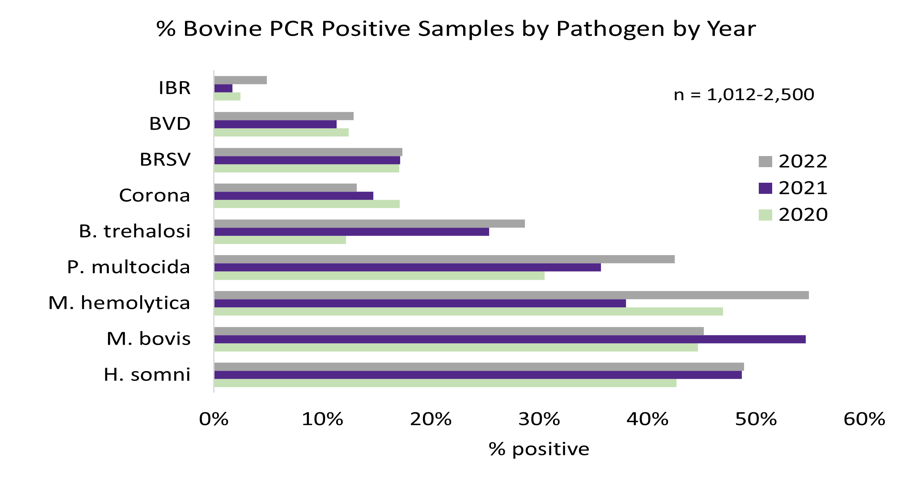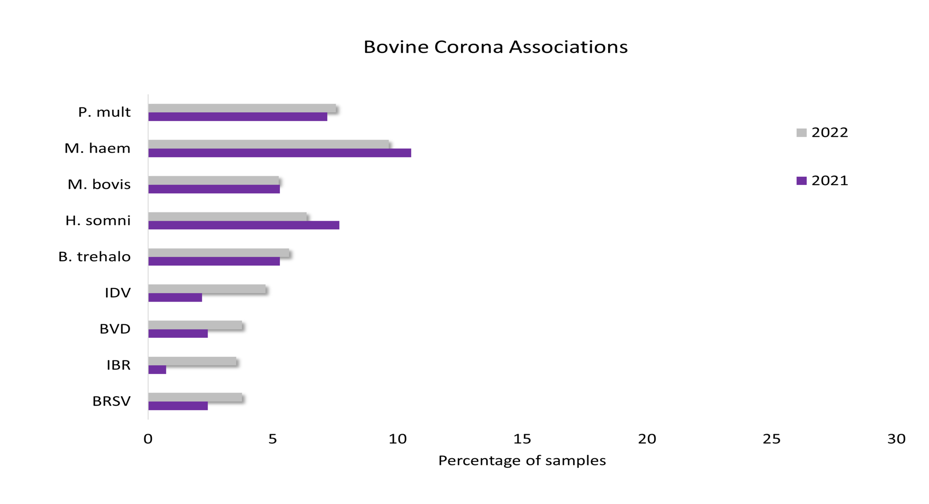
October 2023
Bovine Corona Virus: A Respiratory Pathogen in Pre-weaned Beef Calves?
By Dr. Gregg Hanzlicek
One of the most common questions we receive concerns bovine corona virus’ (BCoV) role in respiratory disease. At this time, there doesn’t seem to be a consensus in the scientific community to its involvement, although many of us in the KVDL believe it can be either a primary or secondary respiratory pathogen.
Presented below is a partial summary of KVDL’s passive surveillance program highlighting BCoV.
From 2020 through 2022, BCoV was identified by PCR in 13-18% of the respiratory samples submitted. (Figure 1) In this same set of samples, nasal swabs were two times more likely to be BCoV positive compared to lung tissue. (data not shown)
Figure 1. Percentage of submissions containing each pathogen identified by the KVDL’s Bovine Respiratory PCR Panel (MDL-3350, MDL-3380, MDL-3390).
 |
Bovine corona virus was the sole viral pathogen identified by PCR in 3.9%, 3.2%, and 5.1% of the samples in years 2020, 2021, and 2022 respectively. (data not shown) As shown in Figure 2, BCoV is more commonly identified in the same sample with common bacterial and viral respiratory pathogens.
Figure 2. Percentage respiratory pathogens identified with BCoV in the same sample by KVDL’s Bovine Respiratory PCR Panel (MDL-3350, MDL-3380, MDL-3390).
 |
The typical history of potential BCoV associated herd respiratory outbreaks include: 1) pre-weaned beef calves (more commonly during the late-pasture season), 2) well-managed herds with optimal nutrition and vaccination programs, 3) extremely high morbidity with almost no mortality, 4) poor response to antimicrobial treatments, and 5) diagnostic tests identifies BCoV at very low Ct values and as the only viral pathogen present.
Prevention strategies involving off-label vaccinations have been attempted to prevent this preweaning respiratory disease from occurring in subsequent years. These strategies include the use of either parenteral or intranasal enteric BCoV vaccine administration to calves at pasture-turnout or mid-way through the pasture season. The use of autogenous vaccines have also been used to help prevent this respiratory disease.
Many herds, regardless if any changes in preventative programs occur, do not experience BCoV associated issues in subsequent years.
Unfortunately, some herds will continue to experience outbreaks in subsequent years despite instituting multiple preventative programs.